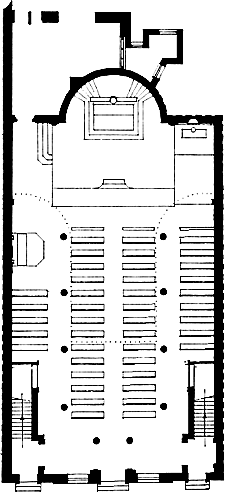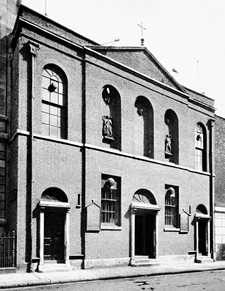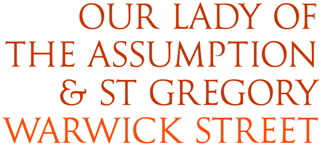History
The church of Our Lady of the Assumption and St. Gregory is located on Warwick Street in Soho. Built in 1789-90 on the site of a Catholic chapel pillaged during the anti-Catholic Gordon Riots of 1780, the church is attached to a fine house in Golden Square, Soho, built in 1685. This house (No. 24) and its neighbour (No. 23) were occupied by the Portuguese Ambassador the Marques de Pombal from 1724 to 1747.
At a time in England when Catholic churches and chapels were not permitted, foreign embassies had the right to have their own chapels, and the Ambassador (later an influential prime minister in his native land) had a chapel constructed at the back of his house. When the Portuguese moved out, the lease was taken over by Count Haslang, the ambassador of the Bavarian sovereign. The embassy was occupied in Golden Square until 1788, so it was the Bavarian ambassador’s chapel that was destroyed during the Gordon Riots.
The current church was built in 1789-90 on the site of the Bavarian chapel by the Bishop of the London District, Bishop Talbot. When the Bavarian embassy left in 1788 the bishop obtained 800-year and 900-year leases of the two vacant houses in Golden Square, together with the chapel and other outbuildings. That September he assigned the ground behind the houses to six trustees for the erection of the new church.
With the patronage of the Elector of Bavaria, Bishop Talbot and a committee of twenty-two prominent Catholics appealed for funds for the erection of a new chapel. Building began in the spring of 1789 to a design by architect Joseph Bonomi, and the new church was opened on 12 March 1790, the feast of St. Gregory the Great, to whom it was dedicated. The connection with the Royal House of Bavaria has been maintained to this day and there is a memorial in the church to the late Crown Prince Albrecht of Bavaria who died in 1955.
Catholic life in England developed steadily during the first half of the nineteenth century. Mrs. Fitzherbert, morganatic wife of the Prince of Wales (later King George IV), worshipped regularly at the church. Blessed John Henry Newman, when a boy, was taken to the church by his father. He later wrote: “All that I bore away from it was the recollection of a pulpit and a preacher and a boy swinging a censer”. The church developed a strong musical tradition early on and became well-known for its musical excellence. This tradition has now been revived at the church. Music by Mozart, Haydn, and Beethoven was performed regularly here during the nineteenth century. Today the music is mostly in the English tradition (Purcell, Stanford, Howells) but does not exclude composers of the European tradition from the sixteenth to nineteenth centuries.
By  1840, Golden Square had ceased to be a fashionable location. Charles Dickens describes it in Nicholas Nickleby as a great resort of foreigners. In 1853, a bas-relief depicting the Assumption (by the Irish artist John Edward Carew) was erected above the high altar. In 1875, the sanctuary was remodeled according to a design by John Francis Bentley — later the architect of Westminster Cathedral. An apse was constructed and decorated with marble and mosaics while the bas-relief of the Assumption was moved to its present location above the portal to the sacristy. Bentley’s full plans for reconstructing the whole church were never completed, however, and the main body of the building remains as it was when built in 1790, except for the shortening of the side galleries so that they no longer reach the east wall of the church. The original gallery pews were left in place while the organ appears to have been built by Lincoln in 1790. It was expanded by Green & Blythe in 1804 with a further enlargement and rebuilding by Bishop & Starr in 1859.
1840, Golden Square had ceased to be a fashionable location. Charles Dickens describes it in Nicholas Nickleby as a great resort of foreigners. In 1853, a bas-relief depicting the Assumption (by the Irish artist John Edward Carew) was erected above the high altar. In 1875, the sanctuary was remodeled according to a design by John Francis Bentley — later the architect of Westminster Cathedral. An apse was constructed and decorated with marble and mosaics while the bas-relief of the Assumption was moved to its present location above the portal to the sacristy. Bentley’s full plans for reconstructing the whole church were never completed, however, and the main body of the building remains as it was when built in 1790, except for the shortening of the side galleries so that they no longer reach the east wall of the church. The original gallery pews were left in place while the organ appears to have been built by Lincoln in 1790. It was expanded by Green & Blythe in 1804 with a further enlargement and rebuilding by Bishop & Starr in 1859.
Warwick Street’s location in the heart of London’s West End between Piccadilly Circus and Soho imparts a special character. Surrounded by both great wealth and extreme poverty, it is a destination for pleasure-seekers and revellers as well as an assembly place of the lonely, the addicted, and street-sleepers. The church remains open throughout the day and offers welcome and consolation to all. We are especially pleased to receive visits from so many tourists from all parts of the world.
After the 10.30 am Mass on a Sunday everyone is invited to coffee, tea, and drinks in the parish rooms downstairs.
At Easter 2013 the Archdiocese of Westminster put the church in the care of the Personal Ordinariate of Our Lady of Walsingham. Formed in January 2011, the Ordinariate was a personal initiative of Pope Benedict XVI to welcome former Anglicans into full communion with the Roman Catholic Church. There are now some 50 Ordinariate groups across Great Britain served by over 80 priests. The Church in Warwick Street is the central church of the Ordinariate and, each Sunday at 10.30am, Mass is offered according to the Ordinariate Use, which incorporates elements drawn from the Anglican liturgical tradition.
In February 2021, His Eminence Vincent Cardinal Nichols has appointed Fr Mark Elliott Smith as Parish Priest, or Rector, of Our Lady of the Assumption and St Gregory.
Please note that the church at Warwick Street functions as a normal Roman Catholic parish and all Catholics who attend this Mass fulfil their Sunday obligation.
Visitors to the 10.30am Sunday Mass will be struck especially by the excellence of the singing. The Anglican tradition on which we draw at Warwick Street contains much sublime music and each Sunday our liturgy is enhanced by these Anglican musical settings.




